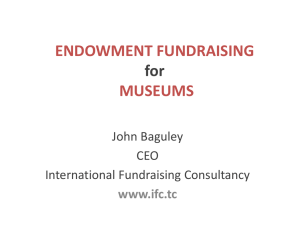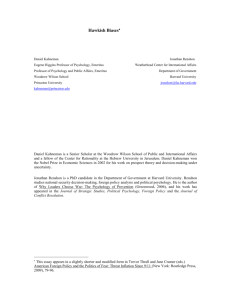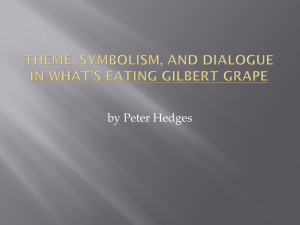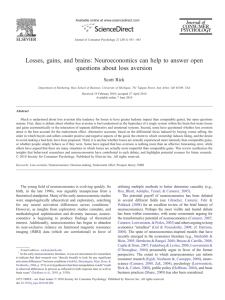Loss Aversion & Endowment Effects
advertisement
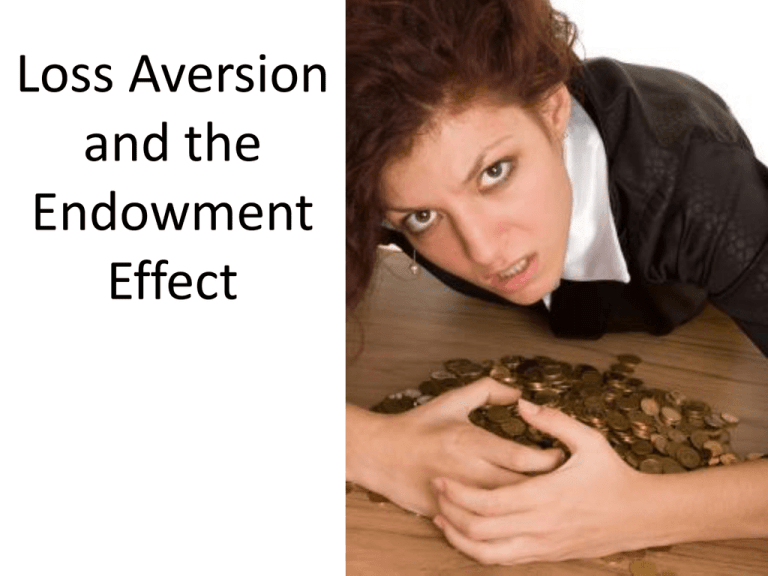
Loss Aversion and the Endowment Effect Reading • Predictably Irrational by Dan Ariely – Chapter 8: The High Price of Ownership • Thinking, Fast and Slow by Daniel Kahneman – Chapter 26: Prospect Theory, “Loss Aversion” – Chapter 27: The Endowment Effect Prospect Theory • This is easily the most famous theoretical contribution to behavioral economics – Prospect Theory: An Analysis of Decision under Risk, by Daniel Kahneman and Amos Tversky, Econometrica, Vol. 47, No. 2 (March 1979), pp. 263-292 • One of the key components of prospect theory is loss aversion Two behavioral economics principles 1. The endowment effect “Ownership creates satisfaction” 2. Loss aversion “People are more motivated by avoiding a loss than acquiring a similar gain” Kahneman and Tversky’s “Prospect Theory” describes how people evaluate gains and losses; it includes concepts such as status quo bias, loss aversion, and the endowment effect The endowment effect • People value a thing more once it becomes theirs • Ownership increases utility • Term originated by Richard Thaler (U. of Chicago) Thaler, R. (University of Chicago), 1980, Toward a positive theory of consumer choice. Journal of Economic Behavior and Organization, March, 39-60. Students in every other seat were given university mugs. Then reported how much they would be willing to sell the mug for. Students who did not get a mug reported the price they would be willing to pay to get one. What happened? a) The students with mugs priced them higher. b) The students with no mugs priced them higher. c) Both sets of students priced them about the same Students with the mugs Students with no mugs were willing to sell them, were willing to buy them, on average, for on average, for $4.50 $2.25 Kahneman, D. (UC Berkley), Knetsch, J. (Simon Fraser U), Thaler, R. (Cornell), 1990, Experimental tests of the endowment effect and the Coase theorem. Journal of Political Economy, 98(6), 1325-1348. Class A At the beginning, students given a coffee mug. At the end, given option to trade for a bar of Swiss chocolate. Class B Students given a chocolate bar. At the end, given option to trade for a coffee mug. ? ? Class C At the beginning, offered a choice between a chocolate bar or coffee mug. ? Class A At the beginning, students given a coffee mug. At the end, given option to trade for a bar of Swiss chocolate. Class B Students given a chocolate bar. At the end, given option to trade for a coffee mug. ? ? Class C At the beginning, offered a choice between a chocolate bar or coffee mug. ? Class A Class B Class C 89% 10% 59% chose coffee mug chose coffee mug chose coffee mug ? ? ? J. Knetsch (Simon Fraser U.), 1989, The endowment effect and evidence of nonreversible indifference curves. American Economic Review, 79, 1277-1284. 33 chimpanzees given frozen-juice popsicle or tube of peanut butter (both familiar items) and then an opportunity to trade. ? ? When initially given peanut butter When initially given popsicle Chose peanut butter Chose peanut butter 89% 42% Brosnan, S. (Emory), et al (Texas, Vanderbilt), 2007, Endowment effects in chimpanzees. Current Biology, 17, 1704-1707. Endowment effect in basketball tickets? Dr. Dan Ariely, Duke University http://www.youtube.com/watch?v=drEVExtrUgQ Carmon, Ziv and Dan Ariely (2000), “Focusing on the Forgone: How Value Can Appear So Different to Buyers and Sellers,” Journal of Consumer Research, 27 (December), 360–70. Duke basketball tickets experiment • At Duke, home-game basketball tickets are distributed by lottery • Ariely gets a list of the winners and losers • Calls the losers and asks how much they’d pay for a ticket ($170 on average) • Calls the winners and asks at what price they’d sell ($1,400) • This is evidence of the endowment effect Duke basketball tickets experiment • The lottery losers were willing to pay $170 on average for a ticket • This means the lottery losers valued a ticket at approximately $170.01 • The lottery winners were willing to sell their tickets for $1400 on average • This means the lottery winners valued a ticket at approximately $1399.99 • Why would two randomly chosen groups value the same thing at such different levels? The endowment effect in art Dr. Dan Gilbert, Harvard University http://www.youtube.com/watch?v=LTO_dZUvbJA 8:25-13:57 Students in a non-credit photography class at Harvard picked two photos to develop then chose one to keep. Group 1 “pick your favorite, … you won’t be able to change your mind.” Group 2 If you change your mind within four days, you can swap it. I’ll call at the end to double-check. Gilbert, D. (Harvard) & Ebert, J. (MIT), 2002, Decisions and revisions: The affective forecasting of changeable outcomes. Journal of Personality and Social Psychology, 82, 503-514 Both before and two days after their choice, participants were asked how much they liked their photograph from 1 (not at all) to 9 (very much) Group 1 Change in satisfaction with picture Group 2 Change in satisfaction with picture +1.3 -1.8 Gilbert, D. (Harvard) & Ebert, J. (MIT), 2002, Decisions and revisions: The affective forecasting of changeable outcomes. Journal of Personality and Social Psychology, 82, 503-514 Gilbert, D. (Harvard) & Ebert, J. (MIT), 2002, Decisions and revisions: The affective forecasting of changeable outcomes. Journal of Personality and Social Psychology, 82, 503-514 Students ranked 6 art posters. Next, allowed to take home either 3rd or 4th ranked poster. 15 minutes later, they rated their chosen poster again. Group A: “if … any time in the next month, you can just let me know and we will exchange it for you.” Group B: Final choice, no exchanges. Gilbert, D. (Harvard) & Ebert, J. (MIT), 2002, Decisions and revisions: The affective forecasting of changeable outcomes. Journal of Personality and Social Psychology, 82, 503-514 Change in ranking of the art poster before and after they chose to take it home. -.07 Group A: “if … any time in the next month, you can just let me know and we will exchange it for you.” +.71 Group B: Final choice, no exchanges. Gilbert, D. (Harvard) & Ebert, J. (MIT), 2002, Decisions and revisions: The affective forecasting of changeable outcomes. Journal of Personality and Social Psychology, 82, 503-514 When allowed to pick their type of choice (changeable or unchangeable), people preferred: 66.3% Group A: “if … any time in the next month, you can just let me know and we will exchange it for you.” 33.7% Group B: Final choice, no exchanges. Gilbert, D. (Harvard) & Ebert, J. (MIT), 2002, Decisions and revisions: The affective forecasting of changeable outcomes. Journal of Personality and Social Psychology, 82, 503-514 When asked which type of choice the typical student would prefer, they believed: 84.3% Group A: “if … any time in the next month, you can just let me know and we will exchange it for you.” 15.7% Group B: Final choice, no exchanges. Gilbert, D. (Harvard) & Ebert, J. (MIT), 2002, Decisions and revisions: The affective forecasting of changeable outcomes. Journal of Personality and Social Psychology, 82, 503-514 Endowment effect and marketing • Money-back guarantees are offered by businesses because it reduces people’s resistance to trying a product • Once someone tries the product, the endowment effect may seal the deal The IKEA effect • One’s sense of ownership of something increases when one invests more of one’s resources in it Virtual Ownership • We may feel as though we already own something if we can vividly imagine taking possession of it and living with it • This virtual ownership leads to a purchase and to actual ownership • Successful advertisements are good at enabling us to vividly imagine life with a product Endowment Effect in Ideas • Once we accept an idea it is very difficult for us to let it go • This is how ideological rigidity sets in • We find it hard to take evidence seriously when it threatens an idea we feel is ours • We only consider evidence when it supports an idea we already believe Gilbert, D. (Harvard) & Ebert, J. (MIT), 2002, Decisions and revisions: The affective forecasting of changeable outcomes. Journal of Personality and Social Psychology, 82, 503-514 Dr. Dan Gilbert, Harvard University http://www.youtube.com/watch?v=LTO_dZUvbJA 14:19-19:05 Loss Aversion People are more motivated to avoid a loss than to acquire a similar gain. Loss Aversion, Measured • Daniel Kahneman on loss aversion: http://www.youtube.com/watch?v=VorB7X5L 8ZY&feature=related • Experiment after experiment has shown that people will accept a gamble with equal odds of a loss and a gain, as long as the gain is roughly 2.5 times the loss Loss aversion and endowment effect Once I own something, not having it becomes more painful, because it is a loss. If I don’t yet own it, then acquiring it is less important, because it is a gain. Loss aversion and framing If the same choice is framed as a loss, rather than as a gain, different decisions will be made. Imagine that the US is preparing for the outbreak of an unusual disease, which is expected to kill 600 people. Choose a program to address the problem. A: 200 people will be saved B: 1/3 chance that 600 people will be saved. 2/3 chance that no people will be saved. Imagine that the US is preparing for the outbreak of an unusual disease, which is expected to kill 600 people. Choose a program to address the problem. 72% A: 200 people will be saved 28% B: 1/3 chance that 600 people will be saved. 2/3 chance that no people will be saved. Tversky, A. & Kahneman, D., 1981, The framing of decisions and the psychology of choice. Science, 211, 453-458. Imagine that the US is preparing for the outbreak of an unusual disease which is expected to kill 600 people. Choose a program to address the problem. A: 400 people will die. B: 1/3 chance that nobody will die. 2/3 chance that 600 people will die. Imagine that the US is preparing for the outbreak of an unusual disease which is expected to kill 600 people. Choose a program to address the problem. 22% A: 400 people will die. 78% B: 1/3 chance that nobody will die. 2/3 chance that 600 people will die. Tversky, A. & Kahneman, D., 1981, The framing of decisions and the psychology of choice. Science, 211, 453-458. Only the framing changed 600 people expected to die… 600 people expected to die… 1/3 chance that nobody will die. 2/3 chance that 600 people will die. = 1/3 chance that 600 people will be saved. 2/3 chance that no people will be saved. 78% ≠ 28% We will take great risks to avoid a loss. Reframing the same option as a loss changes the choices. Tversky, A. & Kahneman, D., 1981, The framing of decisions and the psychology of choice. Science, 211, 453-458. Choose A) A sure gain of $240 B) 25% chance to gain $1000, and 75% chance to gain nothing Choose A) A sure loss of $750 B) 75% chance to lose $1000, and 25% chance to lose nothing We are less likely to risk to get an extra gain We are more likely to risk to avoid a sure loss Tversky, A. & Kahneman, D., 1981, The framing of decisions and the psychology of choice. Science, 211, 453-458. Framing a gamble as a loss or a gain http://www.youtube.com/watch?v=Ng9V2JneJ68 start – 5:54 • When an investor sells a losing stock, she is committing to the loss. • Does loss aversion cause investors to hold losing stocks longer than winning stocks? Study: Tracking 10,000 brokerage accounts from 1987-1993 including 162,948 trades. In any one year… What share of losing stocks were sold? What share of gaining stocks were sold? Study: Tracking 10,000 brokerage accounts from 1987-1993 including 162,948 trades. In any one year… What share of losing stocks were sold? What share of gaining stocks were sold? Odean, T. (UC-Davis), 1998, Are investors reluctant to realize their losses? Journal of Finance, 53, 1775-1798. Would investors have been better off to hold the winners and sell the losers? Average 252-day gain after winners sold Average 252-day gain after other stocks sold, but losing stocks held Would investors have been better off to hold the winners and sell the losers? Average 252-day gain after winners sold +2.35% (better than market) Average 252-day gain after other stocks sold, but losing stocks held -1.06% (worse than market) Odean, T. (UC-Davis), 1998, Are investors reluctant to realize their losses? Journal of Finance, 53, 1775-1798. Why losses hurt more Is there a conflict between the core “elephant” side of the brain and the rational pre-frontal cortex “rider”. Why? http://www.youtube.com/watch?v=G GQLO_iXKlU 3:06-end Using prospect theory to pursue your goals 1. Make it a habit (status quo bias) 2. Own it (endowment effect) 3. Fear its loss (loss aversion) 1. Make it a habit (Goal pursuit becomes the status quo) “Creating a good habit requires much conscious effort, but once the groove has been produced the acts which make up a habitual pattern are not consciously willed.” H. Keane (Australian National University), 2000, Setting yourself free: Techniques of recovery. Health, 4, 324-346. 2. Own it Ownership creates satisfaction (endowment effect). By completely identifying yourself with a future goal, you become more attached to it 3. Fear its loss By “owning” a future goal, immediate temptations which put that future at risk can be framed as a potential loss. Application question Suppose you are advising a friend who wants to become a surgeon. What practical suggestions can you give to help her “own” her identity as a future surgeon?

